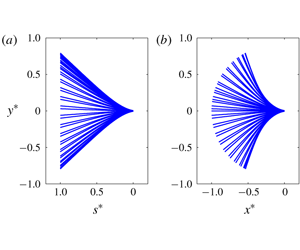Article contents
Passive oscillations of inverted flags in a uniform flow
Published online by Cambridge University Press: 17 December 2019
Abstract

The passive oscillations of inverted flags are investigated both experimentally and theoretically in this paper. First, the force and energy distributions of inverted flags, which contain elastic and inertia components, are analysed based on the experimental data. Two main differences between inverted and conventional flags are found: (1) the elastic energy of a conventional flag is concentrated near the free end, while the fixed end of an inverted flag presents the largest elastic energy; and (2) the elastic component is several orders of magnitude greater than the inertia component for an inverted flag, while they are of the same magnitude for a conventional flag. Second, a linear analysis shows that the critical flow velocities obtained from the experiments at small mass ratios are scattered around the theoretical curve of wavenumber  $k=1.875$, which is in contrast with
$k=1.875$, which is in contrast with  $k=4.694$ of a conventional flag. For large mass ratios, the mass ratio has a certain influence on the critical velocity rather than being irrelevant. For two parallel inverted flags, both the experimental and theoretical results indicate that the range of the in-phase flapping mode becomes smaller with an increase in the separation distance, and a multiple flapping state may occur. For
$k=4.694$ of a conventional flag. For large mass ratios, the mass ratio has a certain influence on the critical velocity rather than being irrelevant. For two parallel inverted flags, both the experimental and theoretical results indicate that the range of the in-phase flapping mode becomes smaller with an increase in the separation distance, and a multiple flapping state may occur. For  $n\geqslant 2$ parallel inverted flags, the theoretical results show that two of all coupled flapping modes are dominant with most parameters. These findings could contribute to a better understanding of the passive oscillations of inverted flags.
$n\geqslant 2$ parallel inverted flags, the theoretical results show that two of all coupled flapping modes are dominant with most parameters. These findings could contribute to a better understanding of the passive oscillations of inverted flags.
JFM classification
- Type
- JFM Papers
- Information
- Copyright
- © 2019 Cambridge University Press
References
- 11
- Cited by


